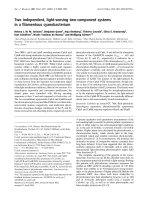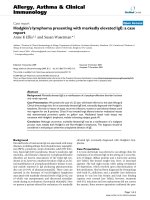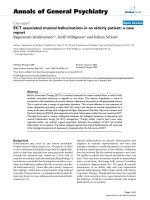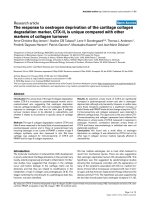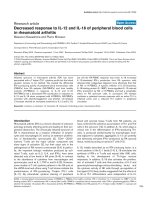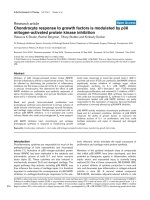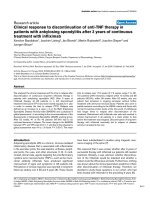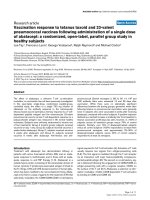Báo cáo y học: "Anaphylactic response to topical fluorescein 2% eye drops: a case repor" pot
Bạn đang xem bản rút gọn của tài liệu. Xem và tải ngay bản đầy đủ của tài liệu tại đây (262.8 KB, 3 trang )
CAS E REP O R T Open Access
Anaphylactic response to topical fluorescein 2%
eye drops: a case report
Humma Shahid
*
, John F Salmon
Abstract
Introduction: The intravenous use of fluorescein 10% during retinal angiography can cause severe systemic
reactions including, on rare occasions, anaphylaxis. Fluorescein 2% eye drops are used extensively for clinical
examination and diagnosis, but to the best of our knowledge, they have only been reported as being responsible
for a systemic anaphylactic response on two previous occasions.
Case presentation: We report the case of a 51-year-old woman who developed an anaphylactic reaction when
she was administered fluorescein sodium 2% eye drops after cataract surgery. This was the second time she had
been exposed to fluorescein. She had brittle asthma and a history of anaphylaxis following exposure to a variety of
drug and food allergens. She was successfully resuscitated and recovered completely over a period of two days.
Conclusions: Fluorescein 2% drops are universally used in general practice, ophthalmology, optometry, and
casualty departments. Our case report reveals the potential for this benign eye drop to cause a life-threatening
systemic reaction and emphasi ses the importance of considering this consequence when administering topical
fluorescein 2% to a patient with a history of anap hylaxis to other allergens.
Introduction
The most commo n cause o f a life- threatenin g medical
emergency in outpatient ophthalmology clinics is the
administration of intravenous fluorescein 10% during
retinal angiographic investigations. Most of the side
effects of intrave nous fluorescein are relatively benign,
and the most common reactions are nausea (2.9%),
vomiting (1.2%), and a combination of flushing, itching
or urticaria (0.5%) [1]. The frequency of severe reactions
to intrav enous fluorescein administration, including lar-
yngeal oedema, bronchospasm, myocardial infarct ion,
cardiac arrest and tonic clonic seizure, is much lower at
0.05% [2]. A recent st udy noted that there were no ser-
ious adverse events or deaths reported from a series of
11,898 fluorescein angiogram studies [3]. The risk of an
anaphylactic reaction to fluorescein during fundus fluor-
escein angiography has an extremely low occurrence,
with one death reported from 220,000 investigations [2].
In most circumstances, an allergic reaction to eye
drops involves a mild l ocalised ocular allergic reaction
which resolves when the drops are discontinued [4].
Reports of anaphylactic reactions following the topical
administration of medici nes to the eye are rare but
potentially fatal. In this report we present the third
known case of a systemic anaphylactic reaction follow-
ing the topical administration of fluorescein sodium 2%
[5,6].
Case presentation
A 51-year-old English woman attended the Oxford Eye
Hospital for a postoperative check-up two weeks after
uneventful phacoemulsification cataract surgery that was
performed under topical anaesthesia. As part of the
ophthalmic examination, fluorescein 2% eye drops
(Bausch and Lomb Minims®) were administered topically
into her operated eye in order to check the corneal
wound i ntegrity and measure the intraocular pressure.
No other eye drops were inst illed into her eye during
her outpatient visit. Within 30 seconds of topical fluor-
escein administration, she developed acute dyspnoea,
wheezing and tachycardia. Well-versed with the symp-
toms of the onset of anaphylaxis, she administered 0.6
mg intramuscular adrenaline from her auto-injector
(EpiPen®). Venous access was obtained and the patient
was given intravenous chlorpheniramine and oral
* Correspondence:
Oxford Eye Hospital, West Wing, Oxford Radcliffe Hospitals NHS Trust,
Oxford, OX3 9DU, UK
Shahid and Salmon Journal of Medical Case Reports 2010, 4:27
/>JOURNAL OF MEDICAL
CASE REPORTS
© 2010 Shahid and Salmon; licensee BioMed Central Ltd. This is an Open Access article distribu ted under the terms of the Creative
Commons Attribution License ( which permits unrestricte d use, distribution, and
reproduction in any medium, provided the original work is properly cite d.
prednisolone. Despite a good initial response, she dete-
riorated acutely within 30 minutes, with tongue swelling,
airway obstruction, and subsequent loss of conscious-
ness. Following appropriate resuscitation, she was trans-
ferred for further observation to the intensive care unit.
She was discharged from our hospital after 48 hours.
Our patient was known to have brittle asthma and a
history of allergy to a number of drugs (Appendix 1)
and foods (Appendix 2). She suffered 10 episodes of
anaphylaxis following inadvertent exposure to these
allergens in the preceding year, one of which necessi-
tated admission to an intensive care unit. She was exam-
ined in the ophthalmology department on two occasions
before the visit described a bove. At the preoperative
assessment prior to cataract surgery, t he intraocular
pressure was measured using a Tono-pen® applanation
tonometer using topical proxymet acaine drops. Cataract
surgery was subsequently performed without any com-
plication under topical anaesthesia (with benoxinate,
proxymetacaine and amethocaine drops). Before she was
discharged from the ophthalmology day surgery unit,
the operated eye was examined and fluorescein drops
were instilled f or the first time. No systemic reaction to
fluorescein was observed at this time.
Two months after the anaphylactic reaction to topical
fluorescein 2%, our patient returned for cataract surgery
on her other eye. No fluorescein was administered at
any stage and she had an uneventful postoperative
recovery.
Discussion
Anaphylaxis is defined as a severe, life-threatening, gen-
eralised or systemic hypersensitivity reaction aff ecting
two or more organs or systems [7]. During the sensitisa-
tion phase of this immediate (type I) hypersensitivity
reaction, an allergen triggers the formation of specific
Immunoglobulin E molecules, which then bind to high
affinity FcεR1 receptors on the surface of tissue mast
cells, basophils, and eosinophils. During the challenge
phase, expo sure to the same allergen results in the
cross-linking of the membrane-bound Immunoglobulin
E molecules on the “sensitised” cells. T his causes degra-
nulation and the release of both the preformed and
newly synthe sised pharmacologically active mediators of
the anaphylactic reaction. The measurement of serum
beta-tryptase released from activated mast cells can be
detected by radioimmunoassay and serves as a specific
marker for anaphylaxis [8].
A true anaphylactic reaction to topical fluorescein 2%
is extremely rare. To the best of our knowledge, only
two previous reports descri be an anaphylactic reaction
following the instillation of fluorescein to the eye [5,6].
Topical fluorescein is widely used in the diagnosis of
corneal abrasions, ulcers, herpetic eye disease, and
corneal wound leaks. It is also used in measuring
intraocular pressure and assessing contact lens fit. The
conjunctiva contains lymphoid tissue in the stroma and
has a rich vascular and lymphatic supply, and can thus
be involved in a regional hypersensitivity response to a
foreign antigen. Given the widespread use of topical
fluorescein, it is not known why the incidence of ana-
phylaxis to this drug is so rare. Although the conjunc-
tiva acts as a barrier to the penetration of molecules,
animal studies have shown that compounds of molecu-
lar weight less than 3,496 daltons are required to elicit
ocular anaphylaxis when applied topically. With a mole-
cular we ight of 376 daltons, sodium fluorescein can
easily pass through the conjunctiva [9]. One could spec-
ulate that by increasing the molecular size of fluores-
cein, perhaps through the addition of an inert
molecular chain, conjunctival absorption, and therefore
the potential of fluorescein to cause an anaphylactic
reaction, could be eliminated.
Our patient was known to be hypersensitive to a vari-
ety of allergens and had brittle asthma. These factors
are known to be associated with increased fatality fol-
lowing an anaphylactic reaction [10]. A strong history of
previous anaphylaxis in a patient indicates the need to
exercise caution when administering new medications
by any route. The first administra tion of topical fluore s-
cein was on the day of the cataract surgery. No reaction
was elicited at this point, and this was probably due to
the sensitising dose of fluorescein. The second admini s-
tration of fluorescein then caused the occurrence of an
anaphylactic reaction.
Conclusions
This case i llustrates how the administration of a see-
mingly benign fluorescein 2% eye drop can have serious
consequences in a susceptible patient. The absence of
an anaphylactic reaction when topical fluorescein is
used for the first time does not preclude a life-threaten-
ing reaction from its subsequent administration in the
same patient. Given the widespread use of fluorescein
eye drops across specialties in primary and secondary
care settings, doctors and other ophthalmic practitioners
need to be aware of this rare response to topical fluores-
cein. It is important to take a good medical and drug
history for every patient. In particular, a reported history
of multiple drug and food allergies is a significant find-
ing, especially if these allergens have triggered anaphy-
laxis on previous occasions.
Consent
Written informed consent was obtained from the patient
for publicatio n of this case report and any accompany-
ing images. A copy of the written consent is avail able
for review by the Editor-in-Chief of this journal.
Shahid and Salmon Journal of Medical Case Reports 2010, 4:27
/>Page 2 of 3
Appendix 1 - Patient’s drug allergies
Aminophylline
Cocaine
Lignocaine
Metformin
Ranitidine
All medications containing sodium metabisulphite
(E223) including paracetamol
Appendix 2 - Patient’s food allergies
All nuts
Shellfish
Mushrooms (canned or dried)
All lettuce (except Iceberg)
Apples
Pears
Dehydrated vegetables
Watercress
Pre-packed foods containing artificial preservatives
Sausages and processed meat
Fruits with stones (peaches, nectarines)
Food additives E220-E228 and E150
Celery
Pepper
Mustard
Authors’ contributions
HS conducted the literature review and wrote the manuscript. JFS critically
reviewed the manuscript. Both authors read and approved the final
manuscript.
Competing interests
The authors declare that they have no competing interests.
Received: 29 October 2009
Accepted: 29 January 2010 Published: 29 January 2010
References
1. Kwiterovich KA, Maguire MG, Murphy RP, Schachat AP, Bressler NM,
Bressler SB, Fine SL: Frequency of adverse systemic reactions after
fluorescein angiography: results of a prospective study. Ophthalmol 1991,
98:1139-1142.
2. Yannuzzi LA, Rohrer KT, Tindel LJ, Sobel RS, Costanza MA, Shields W,
Zang E: Fluorescein angiography complication survey. Ophthalmol 1986,
93:611-617.
3. Kwan AS, Barry C, McAllister IL, Constable I: Fluorescein angiography and
adverse drug reactions revisited: the Lions Eye experience. Clin Exp
Ophthalmol 2006, 34:33-38.
4. Baudouin C: Allergic reaction to topical eyedrops. Curr Opinion Allergy Clin
Immunol 2005, 5:459-463.
5. El Harrar: Anaphylactic shock caused by application of fluorescein on the
ocular conjunctiva. Presse Med 1996, 25:1546-1547.
6. Moneret-Vautrin DA: Apropos of anaphylactic shock caused by
application of fluorescein on the ocular conjunctiva. Presse Med 1997,
26:420.
7. Johansson SG, Bieber T, Dahl R, Friedmann PS, Lanier BQ, Lockey RF,
Motala C, Ortega Martell JA, Platts-Mills TA, Ring J, Thien F, Van
Cauwenberge P, Williams HC: Revised nomenclature for allergy for global
use: report of the Nomenclature Review Committee of the World Allergy
Organization. J Allergy Clin Immunol 2004, 113:832-836.
8. Tanus T, Mines D, Atkins PC: Serum tryptase in idiopathic anaphylaxis: a
case report and review of the literature. Ann Emerg Med 1994, 24:104-107.
9. Kahn M, Barney NP, Briggs RM, Bloch KJ, Allansmith MR: Penetrating the
conjunctival barrier. Invest Ophthalmol Vis Sci 1990, 31:258-261.
10. Pumphrey R: Anaphylaxis: can we tell who is at risk of a fatal reaction?.
Curr Opin Allergy Clin Imunol 2004, 4:285-290.
doi:10.1186/1752-1947-4-27
Cite this article as: Shahid and Salmon: Anaphylactic response to topical
fluorescein 2% eye drops: a case report. Journal of Medical Case Reports
2010 4:27.
Submit your next manuscript to BioMed Central
and take full advantage of:
• Convenient online submission
• Thorough peer review
• No space constraints or color figure charges
• Immediate publication on acceptance
• Inclusion in PubMed, CAS, Scopus and Google Scholar
• Research which is freely available for redistribution
Submit your manuscript at
www.biomedcentral.com/submit
Shahid and Salmon Journal of Medical Case Reports 2010, 4:27
/>Page 3 of 3
